Butterflies and Moths
Media
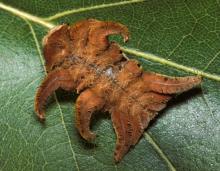
Species Types
Scientific Name
More than 20 species in Missouri
Description
Adult slug caterpillar moths are heavy-bodied and furry. The weird-looking caterpillars have suckers instead of prolegs, so they glide around like slugs. Don’t touch — many have stinging spines or hairs.
Media

Species Types
Scientific Name
Pediasia trisecta
Description
Sod webworms are very common small moths that develop as caterpillars among the roots and leaves of grasses. They are attracted to lights at night.
Media
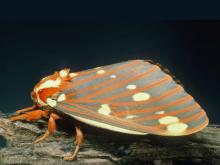
Species Types
Scientific Name
Citheronia regalis
Description
The enormous, horned caterpillars of regal moths are more famous than the winged adults. This splendid moth is well established in the Ozarks and eastern Missouri.
Media

Species Types
Scientific Name
Halysidota tessellaris
Description
Adult banded tussock moths have a distinctive checkered pattern on the wings. The fuzzy, dirty gray caterpillars are more familiar, with their pencils or tussocks of longer, black and white hairs.
Media

Species Types
Scientific Name
Costaconvexa centrostrigaria (formerly Orthonama centrostrigaria)
Description
The bent-line carpet and several similar geometrid moths are called carpet moths for their intricate wing patterns, reminiscent of the traditional carpets of Asia and the Middle East.
Media

Species Types
Scientific Name
Synchlora aerata
Description
The wavy-lined emerald is one of many Missouri moths called emeralds. The emeralds are a subfamily within the geometrid family. Note the scalloped or wavy white lines that run across the wings, pale green fringe on the wings, and a long white stripe running the length of the abdomen.
Media
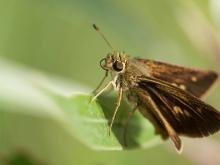
Species Types
Scientific Name
About 275 species in North America north of Mexico
Description
At first glance, skippers look halfway between butterflies and moths. They are commonly seen darting among the flowers they visit on hot summer days.
Media

Species Types
Scientific Name
More than 700 species in North America north of Mexico
Description
Learn about butterflies and skippers as a group. What makes a butterfly a butterfly? How are they different from moths? What are the major groups of butterflies?
Media
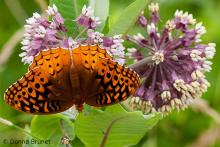
Species Types
Scientific Name
Speyeria cybele
Description
The great spangled fritillary is common and easily recognized. This glorious butterfly is often seen in city yards and gardens as it seeks flowers.
Media
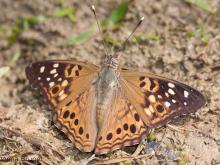
Species Types
Scientific Name
Asterocampa celtis
Description
The hackberry emperor eats hackberry leaves as a caterpillar. The adults fly erratically. They often alight on people to absorb sodium from sweat.
See Also


Media

Species Types
Scientific Name
About 1,500 species in North America north of Mexico
Description
Adult caddisflies are mothlike. Their larvae are aquatic and build portable, protective cases out of local materials, including grains of sand, bits of leaves and twigs, and other debris.
Media

Species Types
Scientific Name
Corydalus cornutus
Description
Adult eastern dobsonflies are huge and mothlike, with large wings and a weak, fluttery flight. The fiercely predaceous aquatic larvae, called hellgrammites, are well-known to anglers, who often use them as bait.
About Butterflies and Moths in Missouri
Butterflies, skippers, and moths belong to an insect order called the Lepidoptera — the "scale-winged" insects. These living jewels have tiny, overlapping scales that cover their wings like shingles. The scales, whether muted or colorful, seem dusty if they rub off on your fingers. Many butterflies and moths are associated with particular types of food plants, which their caterpillars must eat in order to survive.





















